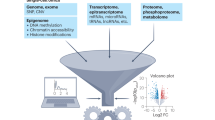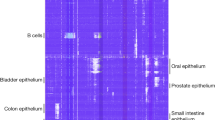Abstract
It is recognized that some mutated cancer genes contribute to the development of many cancer types, whereas others are cancer type specific. For genes that are mutated in multiple cancer classes, mutations are usually similar in the different affected cancer types. Here, however, we report exquisite tumor type specificity for different histone H3.3 driver alterations. In 73 of 77 cases of chondroblastoma (95%), we found p.Lys36Met alterations predominantly encoded in H3F3B, which is one of two genes for histone H3.3. In contrast, in 92% (49/53) of giant cell tumors of bone, we found histone H3.3 alterations exclusively in H3F3A, leading to p.Gly34Trp or, in one case, p.Gly34Leu alterations. The mutations were restricted to the stromal cell population and were not detected in osteoclasts or their precursors. In the context of previously reported H3F3A mutations encoding p.Lys27Met and p.Gly34Arg or p.Gly34Val alterations in childhood brain tumors, a remarkable picture of tumor type specificity for histone H3.3 driver alterations emerges, indicating that histone H3.3 residues, mutations and genes have distinct functions.
This is a preview of subscription content, access via your institution
Access options
Subscribe to this journal
Receive 12 print issues and online access
$209.00 per year
only $17.42 per issue
Buy this article
- Purchase on Springer Link
- Instant access to full article PDF
Prices may be subject to local taxes which are calculated during checkout

Similar content being viewed by others
Change history
06 February 2014
In the version of this article initially published, the name of author Victoria Goody was misspelled, and the following statement was omitted from the Acknowledgments: "The EuroBoNeT consortium, a European Commission–granted Network of Excellence for studying the pathology and genetics of bone tumors, also contributed to the financial support for this study." These errors have been corrected in the HTML and PDF versions of the article.
References
Fletcher, C.D.M. et al. Pathology and Genetics of Tumours of Soft Tissue and Bone 427 (IARC Press, Lyon, France, 2013).
Albig, W. et al. The human replacement histone H3.3B gene (H3F3B). Genomics 30, 264–272 (1995).
Szenker, E., Ray-Gallet, D. & Almouzni, G. The double face of the histone variant H3.3. Cell Res. 21, 421–434 (2011).
Gessi, M. et al. H3.3 G34R mutations in pediatric primitive neuroectodermal tumors of central nervous system (CNS-PNET) and pediatric glioblastomas: possible diagnostic and therapeutic implications? J. Neurooncol. 112, 67–72 (2013).
Gielen, G.H. et al. H3F3A K27M mutation in pediatric CNS tumors: a marker for diffuse high-grade astrocytomas. Am. J. Clin. Pathol. 139, 345–349 (2013).
Khuong-Quang, D.A. et al. K27M mutation in histone H3.3 defines clinically and biologically distinct subgroups of pediatric diffuse intrinsic pontine gliomas. Acta Neuropathol. 124, 439–447 (2012).
Schwartzentruber, J. et al. Driver mutations in histone H3.3 and chromatin remodelling genes in paediatric glioblastoma. Nature 482, 226–231 (2012).
Wu, G. et al. Somatic histone H3 alterations in pediatric diffuse intrinsic pontine gliomas and non-brainstem glioblastomas. Nat. Genet. 44, 251–253 (2012).
Zhang, J. et al. Whole-genome sequencing identifies genetic alterations in pediatric low-grade gliomas. Nat. Genet. 45, 602–612 (2013).
Wülling, M. et al. The nature of giant cell tumor of bone. J. Cancer Res. Clin. Oncol. 127, 467–474 (2001).
Bamford, S. et al. The COSMIC (Catalogue of Somatic Mutations in Cancer) database and website. Br. J. Cancer 91, 355–358 (2004).
Fernández-Medarde, A. & Santos, E. Ras in cancer and developmental diseases. Genes Cancer 2, 344–358 (2011).
Lasky, T. & Silbergeld, E. P53 mutations associated with breast, colorectal, liver, lung, and ovarian cancers. Environ. Health Perspect. 104, 1324–1331 (1996).
Frank, D., Doenecke, D. & Albig, W. Differential expression of human replacement and cell cycle dependent H3 histone genes. Gene 312, 135–143 (2003).
López-Fernández, L.A., Lopez-Alanon, D.M., Castaneda, V., Krimer, D.B. & del Mazo, J. Developmental expression of H3.3A variant histone mRNA in mouse. Int. J. Dev. Biol. 41, 699–703 (1997).
Lewis, P.W. et al. Inhibition of PRC2 activity by a gain-of-function H3 H3 mutation found in pediatric glioblastoma. Science 340, 857–861 (2013).
Chan, K.M. et al. The histone H3.3 K27M mutation in pediatric glioma reprograms H3K27 methylation and gene expression. Genes Dev. 27, 985–990 (2013).
Bjerke, L. et al. Histone H3.3 mutations drive pediatric glioblastoma through upregulation of MYCN. Cancer Discov. 3, 512–519 (2013).
Li, H. & Durbin, R. Fast and accurate long-read alignment with Burrows-Wheeler transform. Bioinformatics 26, 589–595 (2010).
Tarpey, P.S. et al. Frequent mutation of the major cartilage collagen gene COL2A1 in chondrosarcoma. Nat. Genet. 45, 923–926 (2013).
Ye, K., Schulz, M.H., Long, Q., Apweiler, R. & Ning, Z. Pindel: a pattern growth approach to detect break points of large deletions and medium sized insertions from paired-end short reads. Bioinformatics 25, 2865–2871 (2009).
Nik-Zainal, S. et al. Mutational processes molding the genomes of 21 breast cancers. Cell 149, 979–993 (2012).
Van Loo, P. et al. Allele-specific copy number analysis of tumors. Proc. Natl. Acad. Sci. USA 107, 16910–16915 (2010).
Stephens, P.J. et al. The landscape of cancer genes and mutational processes in breast cancer. Nature 486, 400–404 (2012).
Taylor, R.M. et al. CD14− mononuclear stromal cells support (CD14+) monocyte-osteoclast differentiation in aneurysmal bone cyst. Lab. Invest. 92, 600–605 (2012).
Horton, M.A., Lewis, D., McNulty, K., Pringle, J.A. & Chambers, T.J. Monoclonal antibodies to osteoclastomas (giant cell bone tumors): definition of osteoclast-specific cellular antigens. Cancer Res. 45, 5663–5669 (1985).
Horton, M.A., Taylor, M.L., Arnett, T.R. & Helfrich, M.H. Arg-Gly-Asp (RGD) peptides and the anti-vitronectin receptor antibody 23C6 inhibit dentine resorption and cell spreading by osteoclasts. Exp. Cell Res. 195, 368–375 (1991).
Acknowledgements
We are grateful to the patients for participating in the research and to the clinicians and support staff involved in their care. This work was supported by funding from the Wellcome Trust (grant 077012/Z/05/Z), the Skeletal Cancer Action Trust (SCAT), UK, and the Rosetrees Trust UK. The EuroBoNeT consortium, a European Commission–granted Network of Excellence for studying the pathology and genetics of bone tumors, also contributed to the financial support for this study. Material was obtained from the Royal National Orthopaedic Hospital Musculoskeletal Research Programme and Biobank, all of which was coordinated by D. Brooking and R. Grinnell, Biobank staff at the Royal National Orthopaedic Hospital. Support was provided to A.M.F. by the National Institute for Health Research, the University College London Hospitals Biomedical Research Centre and the Cancer Research UK University College London Experimental Cancer Centre. P.J.C. is personally funded through a Wellcome Trust Senior Clinical Research Fellowship (grant WT088340MA). O.M. is funded by the Norwegian Research Council (grant 218241/H10). P.V.L. is a postdoctoral researcher of the Research Foundation-Flanders (FWO). S.B. is funded through the Wellcome Trust PhD Programme for Clinicians.
Author information
Authors and Affiliations
Contributions
S.B. and P.S.T. performed analysis of the sequence data. N. Presneau and R.H. performed the extension screen. S.S. and A.M.F. performed in vitro studies. P.V.L. performed copy number analysis. D.C.W. performed statistical analyses. S.L.C. performed rearrangement analysis. N. Pillay, G.G., H.D. and S.N.-Z. contributed to data analysis. S. McLaren and S. Martin coordinated sample acquisition and processing. V.G. and B.R. performed technical investigations. A.B. and J.W.T. coordinated informatics analyses. D.H., D.B., G.J., B.K., O.M., M.F.A., R.T. and A.M.F. provided samples and clinical data. P.J.C., M.R.S., P.A.F. and A.M.F. directed the research. M.R.S., S.B. and P.S.T. wrote the manuscript, with contributions from P.J.C., A.M.F. and P.A.F.
Corresponding author
Ethics declarations
Competing interests
The authors declare no competing financial interests.
Supplementary information
Supplementary Text and Figures
Supplementary Figure 1 and Supplementary Tables 1 and 2 (PDF 2954 kb)
Source data
Rights and permissions
About this article
Cite this article
Behjati, S., Tarpey, P., Presneau, N. et al. Distinct H3F3A and H3F3B driver mutations define chondroblastoma and giant cell tumor of bone. Nat Genet 45, 1479–1482 (2013). https://doi.org/10.1038/ng.2814
Received:
Accepted:
Published:
Issue Date:
DOI: https://doi.org/10.1038/ng.2814
This article is cited by
-
HIRA vs. DAXX: the two axes shaping the histone H3.3 landscape
Experimental & Molecular Medicine (2024)
-
Pediatric glioma histone H3.3 K27M/G34R mutations drive abnormalities in PML nuclear bodies
Genome Biology (2023)
-
Knockout tales: the versatile roles of histone H3.3 in development and disease
Epigenetics & Chromatin (2023)
-
H3.3 contributes to chromatin accessibility and transcription factor binding at promoter-proximal regulatory elements in embryonic stem cells
Genome Biology (2023)
-
Differential effect of histone H3.3 depletion on retroviral repression in embryonic stem cells
Clinical Epigenetics (2023)



